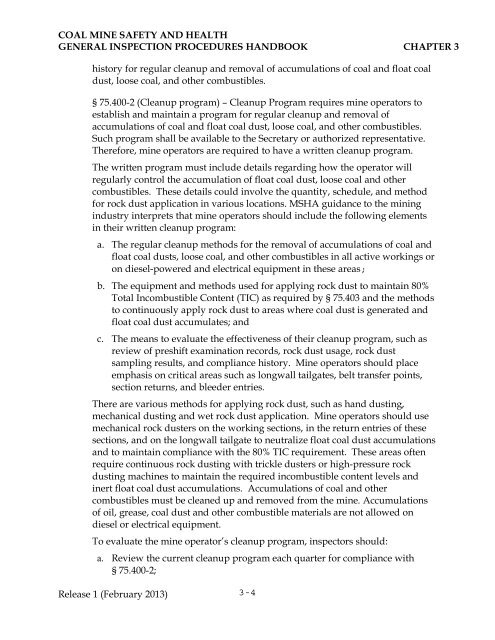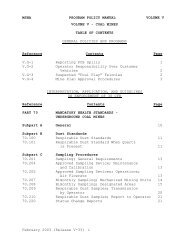MSHA HANDBOOK SERIES - PH13-V-1 - Mine Safety and Health ...
MSHA HANDBOOK SERIES - PH13-V-1 - Mine Safety and Health ...
MSHA HANDBOOK SERIES - PH13-V-1 - Mine Safety and Health ...
You also want an ePaper? Increase the reach of your titles
YUMPU automatically turns print PDFs into web optimized ePapers that Google loves.
COAL MINE SAFETY AND HEALTH<br />
GENERAL INSPECTION PROCEDURES <strong>HANDBOOK</strong> CHAPTER 3<br />
history for regular cleanup <strong>and</strong> removal of accumulations of coal <strong>and</strong> float coal<br />
dust, loose coal, <strong>and</strong> other combustibles.<br />
§ 75.400-2 (Cleanup program) – Cleanup Program requires mine operators to<br />
establish <strong>and</strong> maintain a program for regular cleanup <strong>and</strong> removal of<br />
accumulations of coal <strong>and</strong> float coal dust, loose coal, <strong>and</strong> other combustibles.<br />
Such program shall be available to the Secretary or authorized representative.<br />
Therefore, mine operators are required to have a written cleanup program.<br />
The written program must include details regarding how the operator will<br />
regularly control the accumulation of float coal dust, loose coal <strong>and</strong> other<br />
combustibles. These details could involve the quantity, schedule, <strong>and</strong> method<br />
for rock dust application in various locations. <strong>MSHA</strong> guidance to the mining<br />
industry interprets that mine operators should include the following elements<br />
in their written cleanup program:<br />
a. The regular cleanup methods for the removal of accumulations of coal <strong>and</strong><br />
float coal dusts, loose coal, <strong>and</strong> other combustibles in all active workings or<br />
on diesel-powered <strong>and</strong> electrical equipment in these areas;<br />
b. The equipment <strong>and</strong> methods used for applying rock dust to maintain 80%<br />
Total Incombustible Content (TIC) as required by § 75.403 <strong>and</strong> the methods<br />
to continuously apply rock dust to areas where coal dust is generated <strong>and</strong><br />
float coal dust accumulates; <strong>and</strong><br />
c. The means to evaluate the effectiveness of their cleanup program, such as<br />
review of preshift examination records, rock dust usage, rock dust<br />
sampling results, <strong>and</strong> compliance history. <strong>Mine</strong> operators should place<br />
emphasis on critical areas such as longwall tailgates, belt transfer points,<br />
section returns, <strong>and</strong> bleeder entries.<br />
There are various methods for applying rock dust, such as h<strong>and</strong> dusting,<br />
mechanical dusting <strong>and</strong> wet rock dust application. <strong>Mine</strong> operators should use<br />
mechanical rock dusters on the working sections, in the return entries of these<br />
sections, <strong>and</strong> on the longwall tailgate to neutralize float coal dust accumulations<br />
<strong>and</strong> to maintain compliance with the 80% TIC requirement. These areas often<br />
require continuous rock dusting with trickle dusters or high-pressure rock<br />
dusting machines to maintain the required incombustible content levels <strong>and</strong><br />
inert float coal dust accumulations. Accumulations of coal <strong>and</strong> other<br />
combustibles must be cleaned up <strong>and</strong> removed from the mine. Accumulations<br />
of oil, grease, coal dust <strong>and</strong> other combustible materials are not allowed on<br />
diesel or electrical equipment.<br />
To evaluate the mine operator’s cleanup program, inspectors should:<br />
a. Review the current cleanup program each quarter for compliance with<br />
§ 75.400-2;<br />
Release 1 (February 2013) 3-4
















